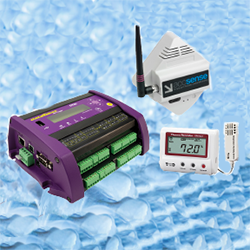
The 6 most important parts of a temperature monitoring system
Mike Edwards
Features measurement probe
In the last few years it’s become increasingly common for hospitals, clinics, healthcare and life science organizations and other business to use an electronic temperature monitoring system to safeguard their products and satisfy regulatory demands.
You may know that you need a monitoring system possibly with alarming capabilities but aren’t sure how to select the best one to meet your needs. To complicate matters, there are literally dozens of different types of temperature monitoring systems with different features and a wide range of prices.
Whether you’re tasked with recommending what to buy, a purchasing agent or the ultimate end user, you can ensure that you’re getting the right system by learning a bit about the most important parts to focus on. CAS DataLoggers presents this basic tutorial covering the 6 parts to a typical temperature monitoring system to help you know what to look for.
Guard Critical Products and Processes
Consider each of these six factors when specifying/selecting a temperature monitoring system:
1. Temperature Probe or Sensor — The type of temperature probe type will affect the measurement accuracy and the temperature measurement range. Common sensor types include:
- Thermocouple
- RTD
- Thermistor
2. Thermal Buffer—A thermal buffer helps smooth rapid temperature fluctuations at the sensor due to compressor cycling, door opening, or loading/removing products. Thermal buffers come in the form of:
- Nylon block
- Bottle filled with ethylene glycol
- Bottle filled with glass beads.
3. Temperature Measurement Device—The heart of the system, it connects to the probe to measure and possibly record the temperature. There are many kinds of these:
- Standalone monitoring device with local memory to store measured data
- Networked/LAN or WiFi measurement device with or without local memory
- Wireless measurement device using proprietary communication protocol with base station or gateway, again with or without local memory
4. Data Storage— While all monitoring applications require some type of immediate data reporting, most also include recording values for historical purposes. The location and amount of memory determines how much historical data will be available. Memory can be:
- Internal memory
- Local base station or gateway
- Local PC
- Cloud-based service
5. Software—Of course, any system will require some software to control the operation of the system. Software functions include:
- Configuration
- Charting
- Alarm management
- Data retrieval
- Reporting
6. Alarming—Most users want immediate notification of temperature excursions outside of the safe operating range. Alarm delivery methods include:
- Visual indicator
- Audible alarm
- Email message
- SMS—Text message
- Phone call
This article is from a blog posted by CASdataloggers. Read more
Print this page